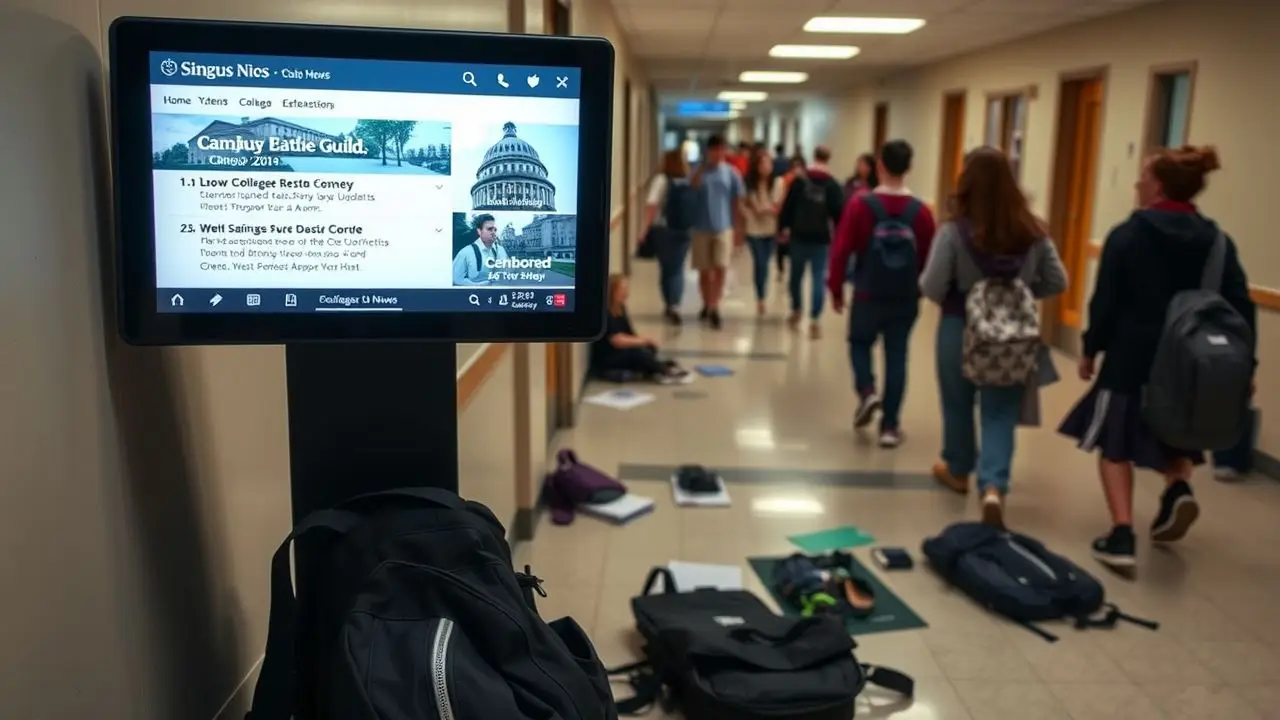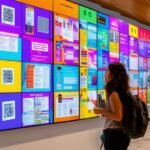Colleges often struggle to keep everyone informed. Digital signage offers a quick way to share news and updates on campus. This blog shows how screens around colleges improve communication from admissions to alumni.
Read on for simple solutions.
Key Takeaways
- Digital signage helps colleges share updates and information quickly. This keeps students and staff informed about classes, events, and emergencies.
- Screens make learning more interactive. They can show maps, videos, and event info which makes campus life better for students.
- Using digital signs can improve safety by sharing alerts fast. It also helps all students get the information they need in a way they understand.
- Colleges use screens to show achievements and upcoming events. This builds school spirit and gets more people to join in.
- Setting up digital signage needs planning. You need a team, money plan, right spots for screens, good tools to manage content, and the right software.
Table of Contents
ToggleBenefits of Digital Signage in Higher Education

Digital signage improves communication on campus. It gives students and staff real-time updates and information easily.
Improved communication with students and staff
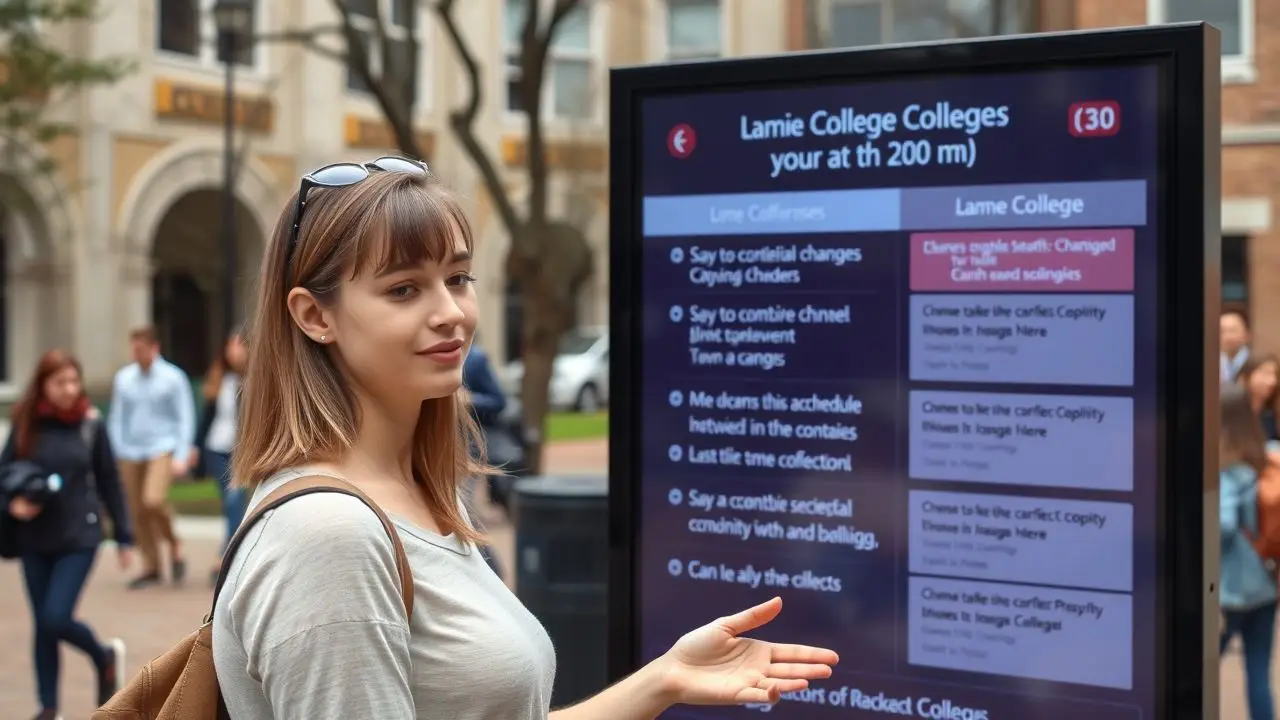
Digital signage improves communication with students and staff on campus. It offers quick updates about classes, events, and other important news. Screens placed around the college provide real-time messages that everyone can see.
This way, students stay informed without waiting for emails or announcements.
Staff also benefit from clear displays. They can share information easily across different departments. Digital messaging makes it simple to promote events or changes in the academic schedule.
With this technology, college campuses become more connected places for all users.
Real-time updates and information
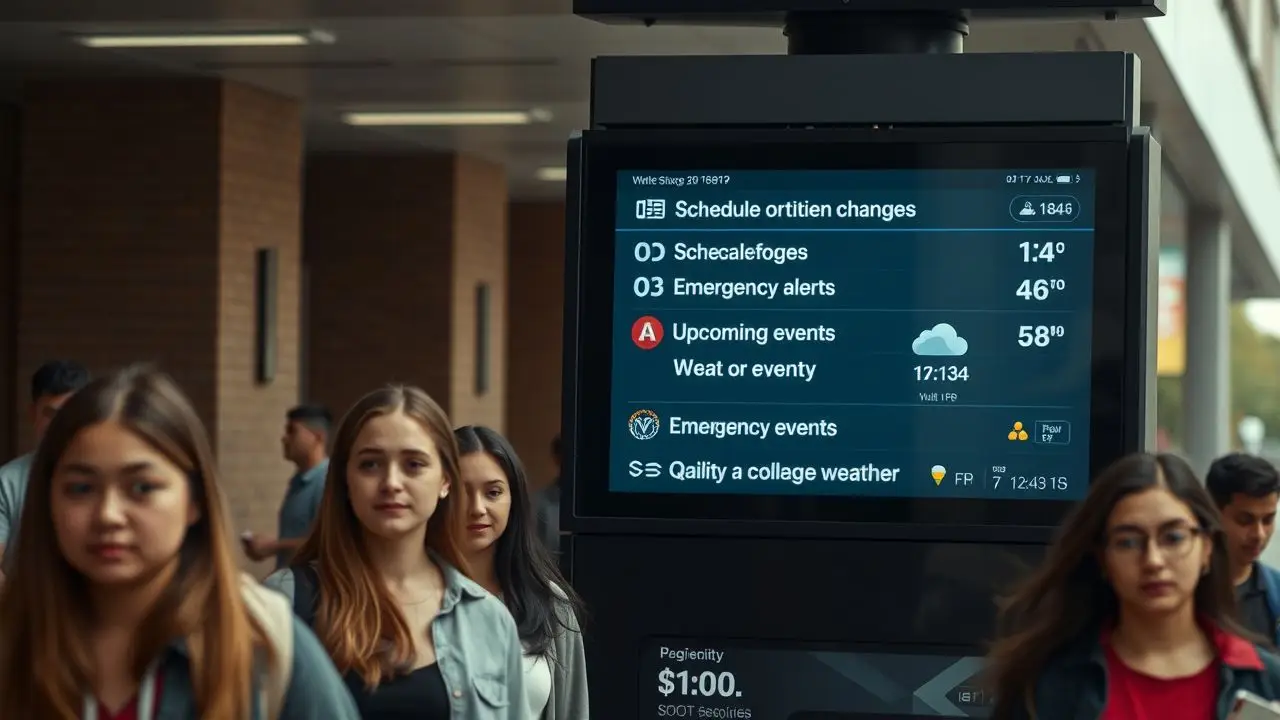
Real-time updates keep students informed. Campuses can share news and alerts quickly. For example, if there is a schedule change or emergency, digital signage shows this information right away.
Students no longer need to wait for emails or flyers. They see important messages on college campus screens as soon as they happen.
Schools use digital displays for events too. Upcoming concerts, sports games, and workshops appear instantly to engage students. Weather updates help everyone prepare for their day.
With student information displays across the campus, communication becomes easy and fast. This makes life smoother for all in the educational setting.
Interactive and engaging learning experiences

Digital signage creates interactive and engaging learning experiences on college campuses. Students can use touchscreens to get information. They can find their way around campus using digital maps.
Signs can also show videos that relate to lessons or campus events.
These displays capture students’ attention better than static signs. They can promote student engagement with fun facts, quizzes, or polls. This kind of interaction helps make learning more memorable and enjoyable for everyone involved.
Digital signage adds a modern touch to education while enhancing the overall campus experience.
Ways to Use Digital Signage on College Campuses
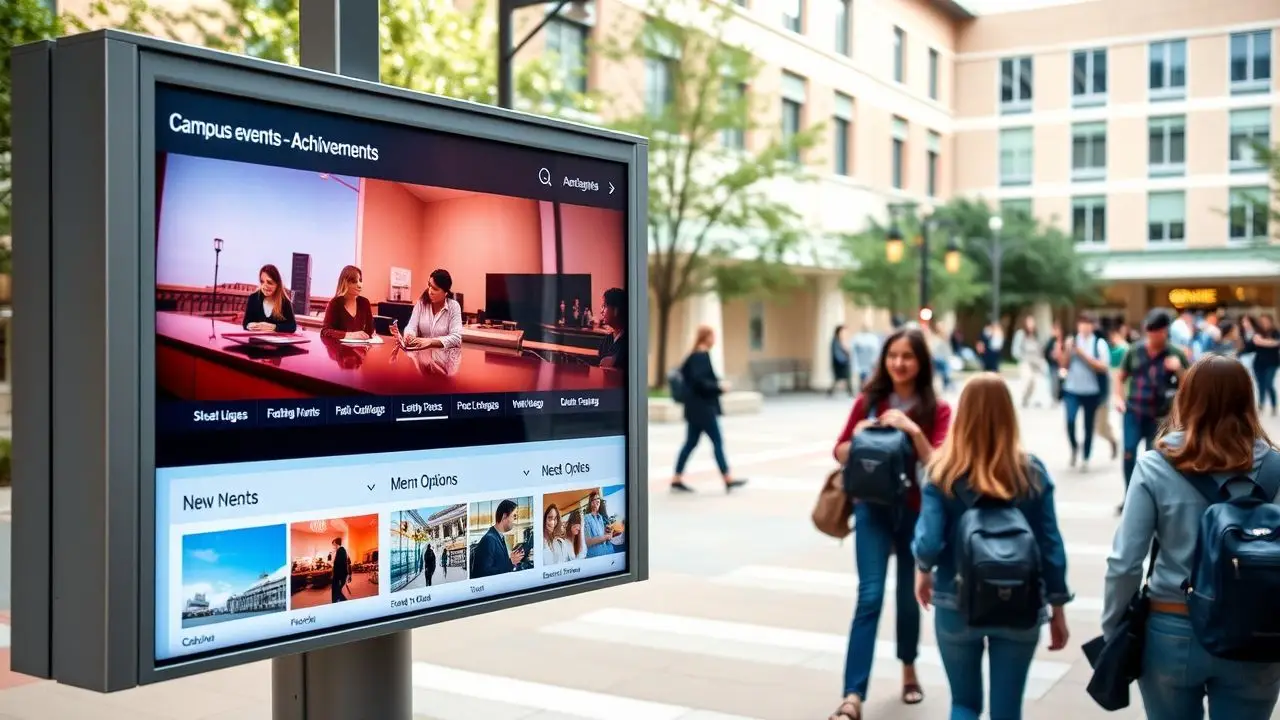
Colleges can use digital signage in many ways to keep everyone informed. You can share menus, news, and updates while also showing achievements and events.
Displaying daily menus and specials
Digital signage can show daily menus and specials at campus dining halls. This helps students see what food is available each day. It can display options for breakfast, lunch, and dinner.
Students get real-time updates about menu changes or special events.
Using screens in the student union makes it easy for everyone to see meals offered that day. Bright visuals attract attention and spark interest in healthy choices. Digital campus messaging not only informs but also enhances the experience of eating on campus.
Sharing news and weather updates
Sharing news and weather updates is key for college campuses. Digital signage can display important announcements quickly. Students and staff will see messages about campus events, changes in schedules, or emergency alerts.
This real-time communication keeps everyone informed.
Weather updates are also vital on campus. Signs can show forecasts to help students plan their day. They might learn if rain is coming or how cold it will be. This helps them dress appropriately and stay safe while moving around the school.
College campuses benefit from clear messages that improve campus communication and keep everyone connected.
Showcasing achievements and upcoming events
Digital signage plays a vital role in showcasing achievements and upcoming events on college campuses. Schools can display student honors, club accomplishments, and sports victories on large screens.
These displays celebrate success and build school spirit.
Upcoming events also benefit from digital signage. Colleges can promote lectures, concerts, or festivals to the campus community. Students see information quickly and easily. They stay informed about what is happening around them.
This helps increase attendance at events while making the campus feel alive with activity.
Assisting with wayfinding and navigation
Wayfinding and navigation on college campuses are vital for students and visitors. Campus digital signage helps people find their way easily. Maps on screens show where to go for classes, offices, or events.
These signs can highlight important buildings like libraries and student unions. They also guide users toward parking lots and dining areas. With clear directions from campus digital displays, no one needs to feel lost while exploring the school grounds.
Enhancing the overall campus experience
Digital signage improves the campus experience for everyone. Students see menus, events, and news on screens around campus. This makes it easier to stay informed. Signs can also help with directions on busy days or during big events.
Events are showcased through digital boards as well. These screens promote club meetings, speaker series, and sports games. They capture attention quickly and create excitement among students.
With these tools, campuses become lively places where everyone feels connected and engaged.
How to Implement Digital Signage on Campus

To start using digital signage on campus, form a team to lead the project. Next, create a budget and choose the best spots for screens around the school.
Creating an internal team
Creating an internal team is a key step for using digital signage on campus. Start by gathering staff from different departments. Include members from communications, IT, and facilities management.
Each person brings useful skills to the team.
This group will help plan and manage the digital signage system. They can decide where to place university digital signage around campus. Team members can also share their ideas for content that fits student needs.
Working together ensures clear communication across the college campus information screens.
Setting a budget
Budgeting for digital signage on campus is key. Start by deciding how much money you can spend. Look at all costs, including screens, software, and installation. Factor in ongoing maintenance too.
Involve your team in this process. They can help find the best options within your budget. Take time to research different solutions that fit both needs and costs. A well-planned budget will make sure your campus communication technology runs smoothly and meets goals effectively.
Determining installation sites
Choosing the right spots for digital signage is key. Start by looking at areas with high foot traffic. Student unions, libraries, and dining halls are great places to install screens.
These locations can grab students’ attention quickly.
Next, think about visibility. Signs must be easy to see and read from a distance. Place them where they can help with campus wayfinding or promote events effectively. Consider outdoor areas too, like entrances and gathering spaces.
Proper placement enhances overall campus communication and boosts student engagement with important information.
Managing the system
Managing the digital signage system on campus is vital. First, form a team to oversee the process. This group should include IT staff and communications experts. They will handle updates and maintenance of digital screens.
Next, set budget limits for equipment and software. Purchase reliable tools that fit your needs. Choose locations for installation carefully, such as student unions or main hallways.
Keep content fresh by scheduling regular updates about events, menus, and safety information. Engaging messages help improve campus communication and create an inviting atmosphere for students and alumni alike.
Utilizing software solutions
Software solutions make managing digital signage easier. They help schools create and update content quickly. Many universities use these tools to display campus event promotions, academic schedules, and safety messages.
These programs offer features like templates for quick design changes.
Schools can also use software for interactive maps. This helps students find their way around campus easily. Information kiosks benefit from updates in real time as well. With the right software, colleges enhance their branding while keeping students informed and engaged on campus.
Transforming Campus Communication with Digital Signage

Digital signage changes how campuses share information. It helps schools connect better with students and faculty through quick updates and engaging content.
Real-life examples of digital signage on college campuses
Many college campuses use digital signage to improve communication. For instance, the University of Southern California displays academic schedule information on screens in key buildings.
Students can see class times and updates easily.
At Arizona State University, electronic bulletin boards share news about events and weather. The student union uses digital messaging to promote specials in dining areas. This helps students make informed choices quickly, enhancing their experience on campus.
Also, interactive campus maps guide new students around the university. These examples show how digital signage plays a vital role in modern education settings.
The role of technology in modernizing education
Technology plays a big part in modernizing education. It helps schools and colleges connect better with students and staff. Digital signage is one tool that makes this easier. Screens across campus can show important updates quickly.
For example, academic schedule displays keep everyone informed about class times and changes.
These digital boards also enhance learning experiences. Students engage more when they see interactive content on campus screens. They can find information about events or achievements easily through university digital bulletin boards.
Technology not only improves communication but also creates a visually appealing campus environment for everyone involved from admissions to alumni.
Improving campus safety and security
Digital signage helps improve campus safety and security. Colleges can display real-time alerts about emergencies or weather conditions. This keeps students and staff informed quickly.
Screen messages can guide people during emergencies, like severe weather or lockdowns. Clear directions help everyone find safe exits easily. Digital wayfinding adds to security by showing where to go in case of trouble.
Overall, this technology supports a safer campus environment for all.
Meeting the needs of diverse learners
Many students have different needs in learning. Digital signage helps meet these needs by providing clear and accessible information. Screens can display text in large fonts for those with vision challenges.
They can also show videos with captions for hearing-impaired students.
At some colleges, digital signs share messages in multiple languages. This supports international students who may not be fluent in English. Real-life examples include student unions using digital screens to communicate events clearly and effectively to all learners on campus.
Digital signage makes it easier for everyone to stay informed and engaged at their educational institution.
Creating a visually appealing campus environment
Digital signage improves the look of college campuses. Bright screens attract attention. They show colorful messages, events, and art. This adds beauty to the environment.
Students enjoy walking past these displays. The signs share news and important information clearly. Many schools use digital screens for branding too. Vibrant graphics create a strong university identity.
First-hand experience shows that such changes make spaces more inviting for students and visitors alike. Digital messaging enhances campus life by keeping everyone informed while beautifying the surroundings.
Conclusion
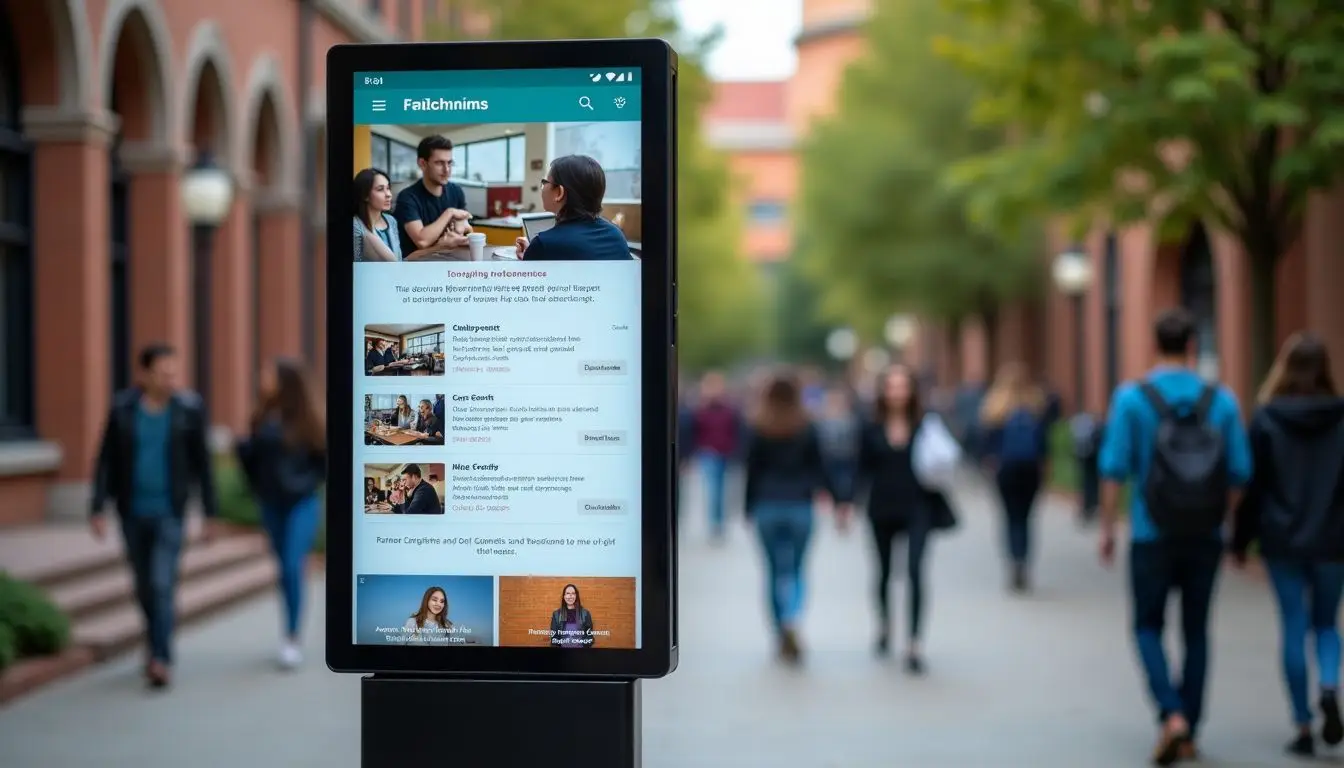
Digital signage changes campus life. It helps students and staff stay informed. Schools can share news, events, and menus easily. This technology makes campuses more welcoming and safe for everyone.
With digital signs, colleges connect better with all their people.
FAQs
1. What is digital signage in the context of a college campus?
Digital signage for higher education refers to on-campus electronic displays used for various purposes, from showing directions with campus directional signage to sharing announcements via student union digital messaging.
2. How does digital signage contribute to university branding and alumni relations?
University branding can be enhanced through educational institution digital screens displaying school colors, logos, and core values. For alumni relations, these signs can share updates about past students or upcoming events, keeping alumni connected to their alma mater.
3. Can you explain how wayfinding displays work on a college campus?
College campus wayfinding displays are part of the broader category of educational signage used across campuses. These signs help guide students, staff, and visitors around the complex infrastructure of an institution using clear directions and maps.
4. How has technology impacted the use of traditional signs on campuses?
Campus technology advancements have led to an increased use of digital signage across all areas – from admissions offices to alumni centers – replacing static boards with dynamic screens that offer real-time information updates.
